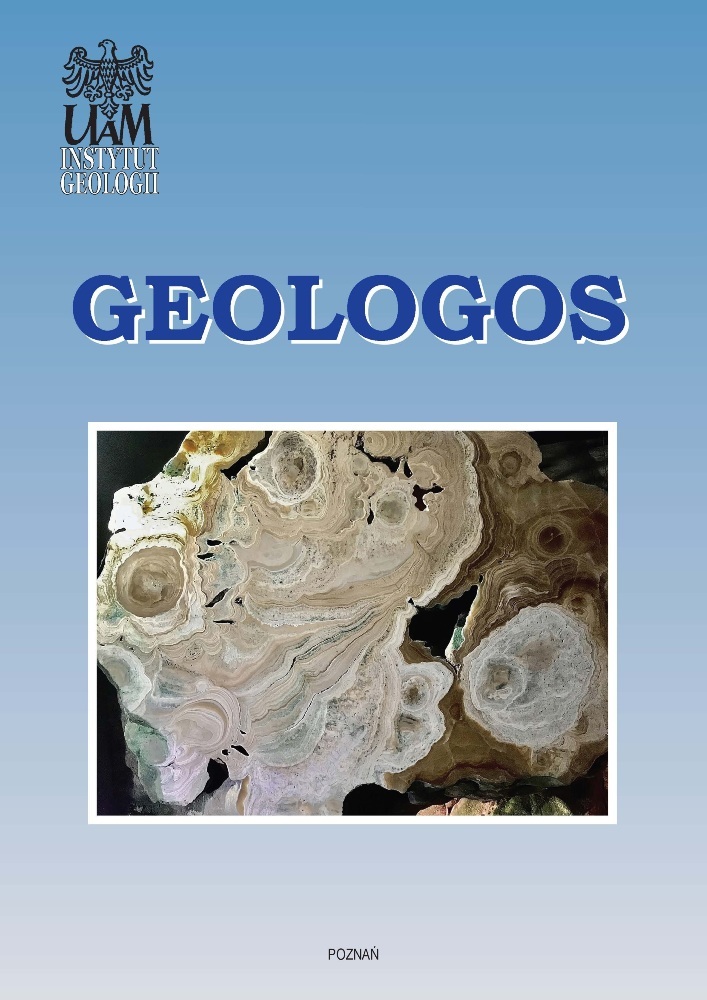Abstract
The date of fall of the Morasko iron meteorite was determined by means of thermoluminescence measurements of the fusion crust and related local materials. Three small pieces, commonly referred to as ‘shrapnel’, were used. The results obtained are 4.5-5.0 ka, which is in good agreement with previous estimates of 4-6 ka on the basis of radiometric, do-simetric and palynological methods.References
Adamiec, G. & Aitken, M.J., 1998. Dose-rate conversion factors: update. Ancient TL 16, 37- 50.
Aitken, M.J., 1985. Thermoluminescence Dating. Academic Press, London, 359 pp.
Bluszcz, A., 2000. Datowanie luminescencyjne osadów czwartorzędowych - teoria, ograniczenia, problem interpretacyjne [Luminescence dating of Quaternary sediments- theory, limitations, interpretation problems]. Zeszyty Naukowe Politechniki Śląskiej, Geochronometria 17, 86, 1-104 (in Polish).
Dworzyńska, M. & Muszyński, A., 2010. Co mówią wyniki badań mikrometeorytów z rezerwatu „Meteoryt Morasko” [What are getting the results of Morasko Reserve micrometeorites investigations]. Acta Societatis Metheoriticae Polonorum. Rocznik Pol. Tow. Met. 3, 105-106.
Fedorowicz, S., 2006. Metodyczne aspekty luminescencyjnego oznaczania wieku osadów neoplejstoceńskich Europy Środkowej [Methodological aspects of luminescence dating of Central Europe’s Neopleistocene deposits]. Wydawnictwo Uniwersytetu Gdańskiego, 156 pp. (in Polish).
Hurnik, H. (Ed.), 1976. Meteorite Morasko and the Region of its Fall. Ser. Astronomia 2, Poznań, 64 pp.
Karwowski, L., Pilski, A.S., Muszyński, A., Arnold, S., Notkin, G. & Gurdziel, A., 2011. New finds in the Morasko Meteorite Reserve, Poland. Meteorites 1, 21-28.
Muszyński, A., Kryza, R., Karwowski, Ł., Pilski, A.S. & Muszyńska, J. (Eds), 2012. Morasko - the largest iron meteorite shower in Central Europe. Bogucki Wydawnictwo Naukowe, Poznań, 111 pp.
Prescott, J.R. & Hutton, J.T., 1994. Cosmic ray contributions to dose rates for luminescence and ESR dating: large depths and long-term time variations. Radiation Measurements 23, 497-500.
Science Channel, 2011. Meteorite Men, episode 302 ‘Morasko Poland’.
Stankowski, W.T.J., 2001. The geology and morphology of the natural reserve “Meteoryt Morasko”. Planetary and Space Science 49, 749-753.
Stankowski, W.T.J., 2009. Meteoryt Morasko, osobliwość obszaru Poznania / Morasko meteorite, a curiosity of the Poznań region. Wyd. Nauk. UAM, Poznań, 94 pp.
Stankowski, W.T.J., 2011. Luminescence and Radiocarbon Dating as Tools for the Recognition of Extraterrestrial Impacts. Geochronometria 38, 50-54.
Stankowski, W.T.J. & Bluszcz, A., 2012. Luminescence Dating as Comparative Data to Radiocarbon Age Estimation of Morasko Spherical Depressions. [In:] D. Michalska-Nawrocka (Ed.), Radiometric Dating. Intechopen, 115-126.
Stankowski, W. & Muszyński, A., 2008. Time of fall land some properties of the Morasko meteorite. Materials Science - Poland 26, 879-902.
Stankowski, W.T.J., Raukas, A., Bluszcz, A. & Fedorowicz, S., 2007. Luminescencje Dating of the Morasko (Poland), Kaali, Ilumetsa, Tsoorikmae (Estonia) Meteorite Craters. Geochronometria 28, 25-29.
Wintle, A.G. & Pruszyńska, H., 1983. TL dating of loess in Germany and Poland. PACT 6, 547-554.
License
Copyright (c) 2016 Stanisław Fedorowicz, Wojciech T. J. Stankowski

This work is licensed under a Creative Commons Attribution-NonCommercial-NoDerivatives 3.0 Unported License.
